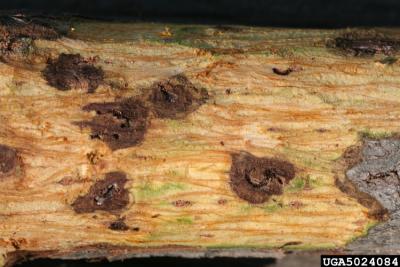
There are six species in the walnut genus, Juglans, native to the United States: Juglans californica (southern California walnut), J. hindsii (northern Calif walnut), J. major (Arizona walnut), J. microcarpa (little walnut), J. nigra (black walnut), and butternut, J. cinerea. Both black walnut and butternut are native to much of the eastern deciduous forest and produce wood that is prized for woodworking and furniture-making. The nuts provide valuable hard mast for wildlife, and humans use them for consumption as well as industrial purposes.
In 2008, scientists determined that a disease was killing black walnut planted in urban settings in the West – that is, outside its native range. It was thousand cankers disease (TCD) which is caused by a previously unknown fungus Geosmithia morbida that is carried from tree to tree by a walnut twig beetle (Pityophthorus juglandis) (Tisserat, 2009). This beetle is native to the Southwestern United States and neighboring Mexico, where it feeds on twigs of Arizona walnut. While its origin is unknown, the fungus is associated with the beetle in Arizona and other places (Tisserat, 2009; Cranshaw, 2009). The disease has been present in parts of the West since at least the 1990s.
Because of the economic importance of black walnut, considerable concern followed discovery of the disease in the West. As a result, states began adopting quarantines and associated regulations in 2010. APHIS conducted a risk assessment (USDA APHIS 2009) but never adopted regulations. Also around 2010, officials detected TCD in a growing number of eastern states. In some cases, outbreaks could be traced to movements of walnut wood from infected regions of the West. Several pathways by which infested wood might be moved were identified: veneer logs, sawlogs, burls, stumps, and firewood. Most worrying was the attractiveness of burls and graft unions from older nut-producing trees in California orchards (called “claro walnut”) (Alexander, 2009; Cranshaw, 2009).
Over the past decade, widespread occurrence of the causative fungus has been discovered in the East; however, it does not appear to cause TCD in black walnut populations growing in the native range – either in the forest or in plantations. Mortality has been observed primarily in urban plantings and in association with drought (Wamsley, 2021). Consequently, many states are terminating their regulatory programs for the disease.
In California, the northern and southern California black walnut were also dying, especially the southern species (Seybold, 2009). Beckman et al. (2021) report that four species of Juglans native to North America have been assigned ranks of Least Concern by the International Union for Conservation of Nature (IUCN). The two exceptions are southern California walnut, Juglans californica, and butternut, J. cinerea. Southern California walnut is threatened by “urban and rural development, overgrazing, and increased recreational use of walnut woodlands”.
Butternut has been severely depleted by a separate fungal disease, butternut canker, caused by Ophiognomonia clavigignenti-juglandacearum. Butternut canker is discussed in a separate profile, here.
For more information on this pest-fungal complex, please visit:
• Thousandcankers.com
Sources
Alexander, K. 2009. Thousand Cankers of Black Walnut National Conference. St. Louis, MO November 2009.
Beckman, E., Meyer, A., Pivorunas, D., Hoban, S., & Westwood, M. 2021. Conservation Gap Analysis of Native U.S. Walnuts. Lisle, IL: The Morton Arboretum. August 2021
Cranshaw, W. 2009. Thousand Cankers of Black Walnut National Conference. St. Louis, MO November 2009.
Hammons, B. 2009. Thousand Cankers of Black Walnut National Conference. St. Louis, MO November 2009.
Potter, K.M., Escanferla, M.E., Jetton, R.M., Man, G., Crane, B.S., 2019. Prioritizing the conservation needs of US tree spp: Evaluating vulnerability to forest insect and disease threats, Global Ecology and Conservation, doi: https://doi.org/10.1016/
Seybold, S. 2009. Thousand Cankers of Black Walnut National Conference. St. Louis, MO November 2009.
Tisserat, N. 2009. Thousand Cankers of Black Walnut National Conference. St. Louis, MO November 2009.
Van Sambeek, J. 2009. Thousand Cankers of Black Walnut National Conference. St. Louis, MO November 2009.
USDA APHIS 2009 Pathway Assessment: Geosmithia sp. and Pityophthorus juglandis Blackman movement from the western into the eastern US (author K.K. Garvey, Colorado State University)
Wamsley, C. 2021. Thousand cankers disease (TCD) – Quarantine and Deregulation. Presentation to the 95th Annual National Meeting of the National Plant Board, July 28, 2021.



